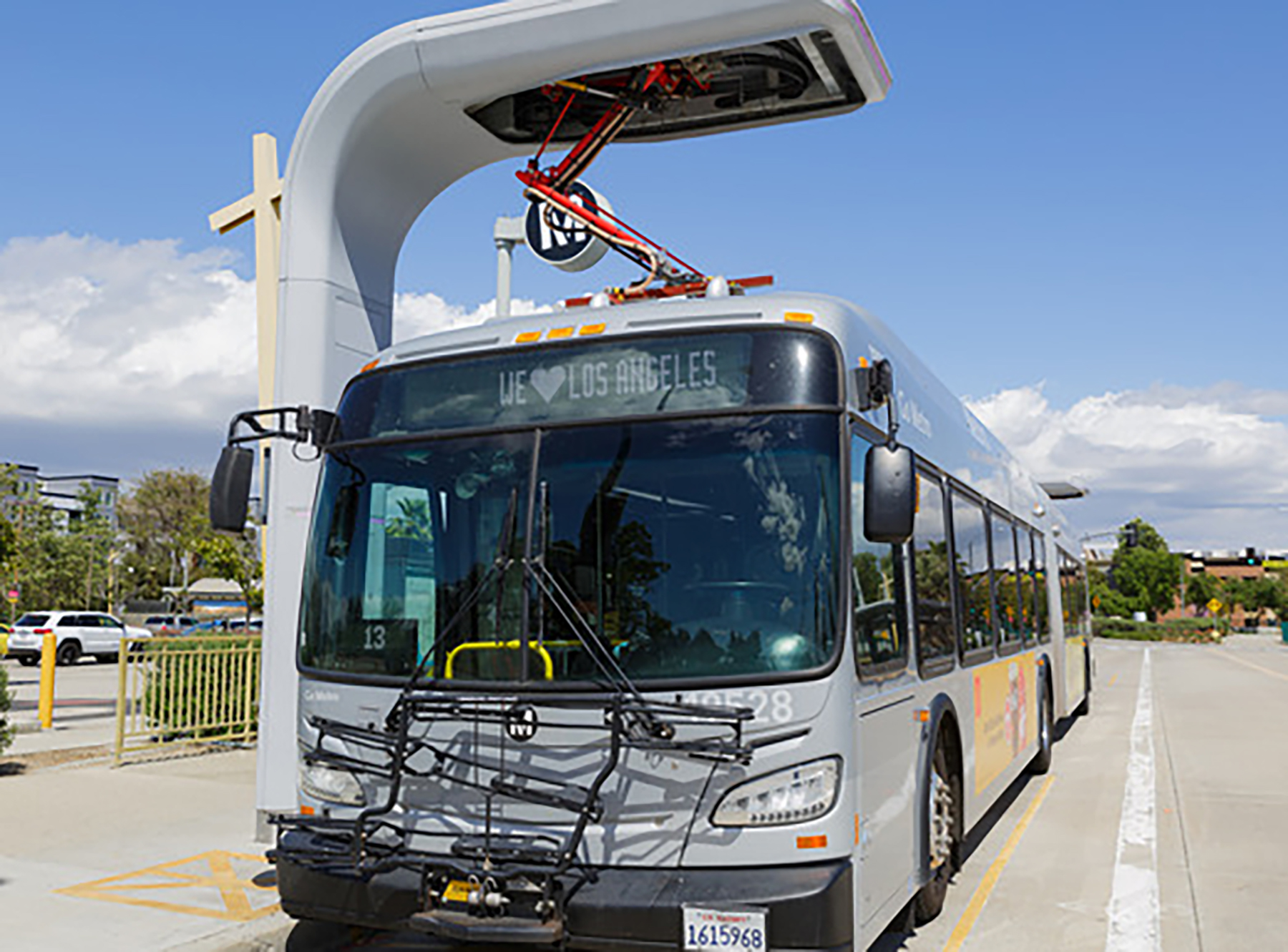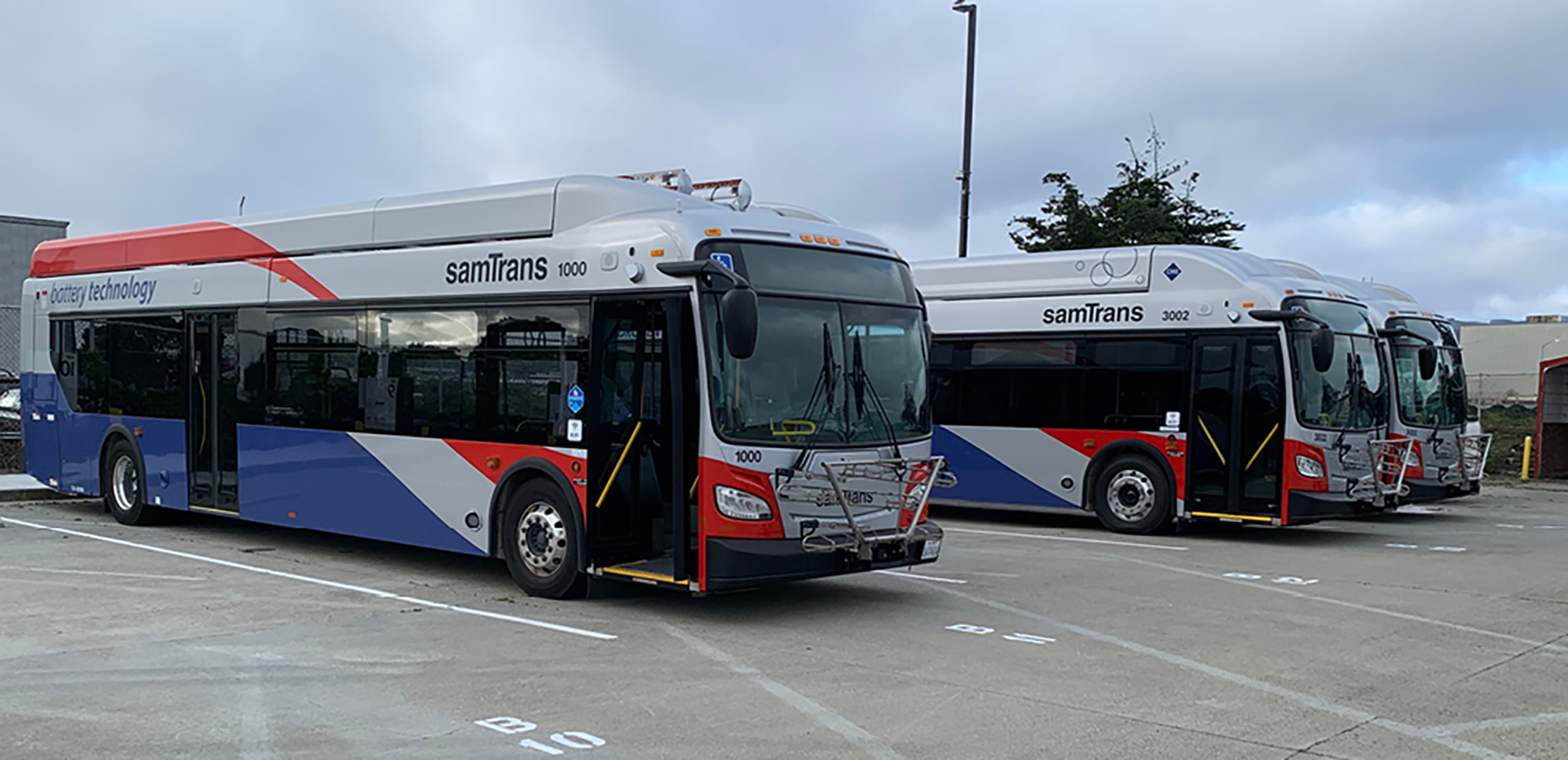By Mark A. Peterson, AIA
California is leading the charge in adopting zero-emission buses to reduce greenhouse gas emissions and meet climate protection goals. Central to this effort is the California Air Resources Board’s Innovative Clean Transit regulation, which mandates a complete transition to zero-emission bus fleets by 2040.
Many California transit agencies are ambitious in their implementation planning, aiming to surpass these requirements and achieve their zero-emission goals ahead of schedule. Currently, the state has the largest zero-emission bus fleet in the U.S., boasting nearly 2,000 full-size transit zero-emission buses funded, ordered, delivered, or deployed.

To advance deployment, California has focused on significant investments in charging infrastructure and utility enhancements, creating a model for other communities nationwide. STV supports the zero-emissions transformation through a diverse array of projects, including new facilities and upgrades to existing ones. Most recently, STV started two new collaborations for zero-emission bus infrastructure upgrades with the San Mateo County Transit District in Northern California and Omnitrans in Southern California.
Further reading:
- How can P3s help transit fleets achieve zero emissions?
- Engineers are essential to help transit agencies electrify fleets
- Public transit’s future is bright, technological, equitable
While some pilot programs are already operational, large-scale zero-emission bus deployments are still in the planning or early execution stages. Regardless of which phase community leaders are in, California’s model offers several key insights into early decision-making and necessary infrastructure upgrades to support the transition to zero-emission buses.
Choosing the right technology
As transit agencies transition to zero-emission fleets, they face the critical decision of choosing battery-electric buses or hydrogen-fuel-cell buses based on the specific needs and characteristics of their transit operations. Both technologies offer unique challenges and opportunities. Initially, many agencies leaned toward battery-electric buses because of their perceived simplicity. However, as hydrogen infrastructure develops, including the production and distribution of hydrogen gas, hydrogen-powered buses are gaining more consideration.
The strategic deployment of both technologies may offer a comprehensive approach to achieving zero-emission transit solutions. For instance, North County Transit District is running pilot programs for both technologies. Meanwhile, Omnitrans, which previously operated a fleet composed entirely of compressed natural gas buses, and the San Mateo County Transit District, which utilized a mix of diesel and gasoline for its transit and paratransit fleets, are contemplating dedicating separate bus bases to each technology, highlighting a strategic approach to incorporating battery-electric and hydrogen-powered buses into their fleets.
Selecting charging methods: Overhead, inductive, or plug-in
Overhead pantographs can be deployed at bus stops or depots where buses position themselves under charging points. Pantographs descend to make contact with buses’ charging interfaces, eliminating the need for manual connection. This method provides automatic and high-current charging and allows for quick, high-power charging sessions.
Inductive (wireless) charging, which STV has designed for Long Beach Transit, uses electromagnetic fields to transfer energy between a charging pad embedded in the ground and a receiver on the bus. The bus parks over the charging pad to initiate the process. This method allows for convenient, hands-free charging but is not as high-power, lacks industrywide standards, and adds significant weight to the vehicles, reducing passenger capacity. However, once standards are established, this charging technology could be advantageously adopted for operations with short, routine circuits such as airport shuttle systems.

Finally, plug-in charging is simpler – buses are equipped with standard plug-in connectors, similar to electric cars – but requires manual connection and disconnection, making it more suitable for smaller fleets. It typically involves slower charging times and is more commonly used for overnight charging in depots. The bus plugs into a dedicated charging station using a cable and connector.
Strategic charging locations: Depot vs. on-route
Most transit agencies prefer depot charging, where buses are charged overnight, often using pantographs managed by charge management systems. This method ensures efficient management of the charging process to optimize energy use and costs. Depot charging ensures buses start their routes fully charged, making it a reliable option.
However, for routes with long distances or high frequencies, on-route or “opportunity” charging is necessary to extend vehicle range. On-route charging involves installing fast chargers at strategic locations, such as transit centers or layover points. For example, the North County Transit District may place on-route chargers where the agency’s buses have dwell time waiting for light rail connections. Similarly, Omnitrans’ bus rapid transit line has a 10-minute headway, allowing for on-route charging infrastructure at the Kendall/Palm intermodal transit center near California State University, San Bernardino.
On-route charging requires careful planning to avoid issues such as right-of-way restrictions and unauthorized parking under charging stations. Additionally, utility-imposed time-of-use charges and rate structures can also significantly impact operating costs for these high-demand systems. Despite these challenges, improvements in charging technology are making on-route charging viable, with faster charging rates enhancing operational efficiency.
To aid these decisions, energy modeling software like STV’s proprietary Performance Evaluation of Electric Bus Routes tool can help agencies analyze General Transit Feed Specification data, topography, passenger loads, starts and stops, and weather conditions to evaluate existing fleet duty cycles and battery technology. By running this comprehensive analysis, PEER identifies optimal routes for zero-emission technologies, helping transit agencies optimize their operations and maximize efficiency. Fundamentally, the tool also estimates the state of charge for buses returning to depots, enabling highly accurate load projections for transit agencies and utility companies to plan necessary infrastructure upgrades.
Infrastructure upgrades for a successful transition
With any of these charging options and combinations, transitioning to battery-electric buses requires substantial infrastructure upgrades to handle new bus technologies and support increased power needs, including:
- Utility coordination: Ensuring utility readiness is crucial, as early and effective coordination with utility companies can prevent delays and ensure the timely deployment of battery-electric buses. Utilities may require a two-year lead for necessary upgrades, even for small pilot programs. To enhance resiliency, agencies should consider obtaining redundant power feeds from separate substations or separate circuits within a single substation, ensuring continuous operation should one power source fail.
- Electrical equipment: New wiring and electrical distribution systems are essential to handle the high-power demands of battery-electric bus charging. Depot layouts must be flexible to accommodate changing bus fleet compositions. Movable pantographs and above-ground power distribution systems allow for easy relocation and scalability, allowing for changing fleet compositions without extensive conduit work. Providing adequate hotel power in maintenance facilities is vital for testing bus systems. This involves installing sufficient power outlets and using portable chargers to support various maintenance activities. Staff training is a crucial component of the success of zero-emission bus programs, effectively transitioning mechanical staff to handle the electrical demands of these buses. Ensuring that employees are equipped with the proper personal protective equipment is essential for maintaining their safety.
- Roof access and fall protection: Maintenance facilities also require upgrades for safe roof access. Given that many new bus components – like battery arrays – are roof mounted, adequate working platforms and corresponding fall protection systems are necessary for safety and efficiency during regular maintenance and inspections.
- Overhead cranes: Overhead cranes, usually with a 2-ton capacity, are becoming increasingly necessary for handling heavy battery racks. These cranes facilitate the removal and replacement of battery arrays on bus roofs, streamlining maintenance operations and minimizing downtime.
- Monitoring systems for thermal runaway events: Implementing robust monitoring systems for thermal runaway events is crucial, especially for buses parked overnight. These systems detect early signs of thermal runaway and alert operators to take necessary actions. Fire suppression strategies, such as increasing fire flow capacity and strategically parking buses to facilitate quick response, are essential to contain and manage such incidents effectively. Standard operating procedures to isolate affected buses and close collaboration with first responders and local fire departments ensure coordinated responses and minimize risks for staff and infrastructure.
- Energy storage: Battery energy storage systems play an important role in enhancing the resilience of transit operations, managing peak demand charges and reducing operational costs through peak shaving. However, these systems are often expensive and require significant space, making widespread implementation challenging. Thermal runaway events pose additional risks, necessitating stringent safety measures. While battery energy storage systems can improve operational resilience and cost management, their high costs and space requirements limit their feasibility for many transit agencies at this time.

The path to adopting proper infrastructure upgrades
Transitioning to zero-emission bus fleets involves addressing several infrastructure and engineering challenges to ensure utility readiness, efficient power distribution, and safe maintenance access. Depot and on-route charging infrastructures must be carefully planned, and transit agencies must choose between battery-electric and hydrogen-powered buses and various charging technologies based on their specific operational needs and infrastructure capabilities. Energy generation and storage solutions offer additional resilience but come with their own set of challenges.
The good news is that there is still time to get these systems in place before the California Air Resources Board’s deadline. Each transit agency must adopt a customized approach, considering all aspects and unique characteristics of their operations.
This article is published by Civil Engineering Online.



